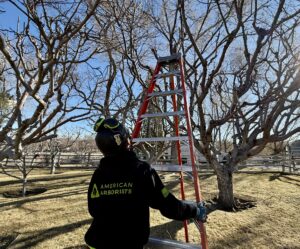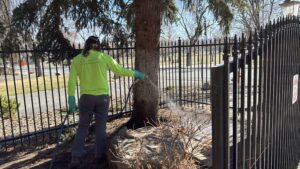Expert Tree Health Care for Reno Since 2007
At American Arborists, we understand that Nevada’s climate presents unique challenges for trees. Between the dry summers, clay-heavy soils, and changing seasons, trees in Reno and Sparks face numerous threats from pests and diseases. Left untreated, these issues can severely damage trees, reduce property value, and create safety hazards.
Our certified arborists provide proactive, science-backed solutions to detect, treat, and prevent tree infestations and infections year-round. With over 400 five-star reviews and a deep understanding of the regional ecosystem, we offer the trusted expertise your trees need to thrive.

If you believe that your tree is suffering from a pest or disease, American Arborists is a phone call away. For the high-quality services you deserve, contact our office at (775) 352-4241.

Why Pest and Disease Management Matters in Northern Nevada
Trees are resilient, but they’re not immune. Insects and pathogens often target trees that are already stressed — a common condition in the high-desert climate of Reno. Infestations and infections can rapidly spread if not addressed early, especially during peak months from spring through early fall.
At American Arborists, we believe in preventative care. Our seasonal scouting, strategic treatments, and tailored injections protect trees from known regional threats before they become irreversible problems.
Common Tree Pests in the Reno Area
Aphids – Green & Woolly
Aphids are small, sap-sucking insects that produce sticky residue and may attract black sooty mold. They’re most active during the warmer months and often cluster in the canopy, creating a mess on walkways and nearby surfaces. Annual treatments help prevent outbreaks and reduce stress on trees.
Caterpillar Pests
Chewed leaves and visible defoliation are common signs of caterpillar damage. While small numbers may seem harmless, larger populations can strip a tree of its foliage, reducing its ability to photosynthesize. Early detection and treatment are key to minimizing long-term damage.
Trunk Borers
These wood-boring insects target stressed trees, especially during dry or hot conditions. Watch for yellowing leaves, dead branches, and sawdust-like frass on the bark. Bark splitting or dieback may occur. Borers often signal deeper health issues, so we combine insect control with strategies to improve overall tree vigor.
Hemlock Woolly Adelgid
This invasive insect targets hemlocks by feeding at the base of needles, leading to needle loss and dieback. The most obvious sign is the presence of white, wool-like masses on the underside of branches. Because infestations can be fatal if left untreated, we offer systemic treatments and monitoring to protect valuable ornamental hemlocks.
Gypsy Moth (Lymantria dispar)
Gypsy moth caterpillars feed voraciously on a wide variety of hardwoods, including oaks and aspens. Their feeding leads to massive defoliation, especially during outbreak years. We recommend preventative treatments during the larval stage and pheromone traps to monitor activity and reduce populations.
Cottony Camellia Scale
Cottony Camellia Scale is a soft scale insect that affects camellias, hollies, and nearby trees by sucking sap and producing cotton-like egg sacs on leaves and stems. This leads to yellowing foliage and honeydew buildup. Our approach includes horticultural oil applications and systemic insecticides to disrupt the insect’s life cycle.
Lace Bug
Lace bugs are tiny, winged pests that feed on the undersides of leaves, causing stippling and bleaching on the upper leaf surface. They particularly affect azaleas, hawthorns, and oaks. We inspect regularly and use insecticidal sprays or soil treatments to control populations before aesthetic damage becomes severe.
Spider Mites
These microscopic pests thrive in hot, dry conditions and often go unnoticed until leaves show speckling, discoloration, or webbing. Spider mites can cause significant stress if left untreated. We control outbreaks with miticides, improved irrigation practices, and seasonal monitoring, especially during drought periods.
Psyllids
Psyllids resemble tiny cicadas and can cause leaf curling, stunted growth, and honeydew production. Some species, like the boxwood psyllid, create unsightly foliage damage. We utilize dormant oil sprays and targeted insecticides to manage these pests while protecting beneficial insects.
Tree Diseases We Treat and Prevent
Foliar Fungal Diseases
Fungal pathogens can spread quickly in the spring and early summer, especially after rainy periods. Look for browning or blackening of leaf margins, spotting, and premature leaf drop. We use targeted fungicide applications and recommend deep root fertilization to support recovery and promote new growth.
Fire Blight
Fire blight is a highly infectious bacterial disease affecting apples, pears, and other members of the rose family. It causes blackened, wilted blossoms and shoots that resemble fire damage. Prompt pruning of infected branches, copper-based sprays, and preventive bactericide treatments in early spring are part of our integrated approach to control outbreaks.
Root Rot
Root rot is caused by poor drainage, overwatering, or fungal infections in the soil, such as Armillaria or Phytophthora species. Symptoms include stunted growth, yellowing leaves, and dieback. We evaluate site conditions, improve soil aeration, and apply fungicidal drenches when appropriate to manage the disease and restore root health.
Anthracnose
Anthracnose is a fungal disease that causes blotchy, brown leaf spots, twig dieback, and defoliation—especially in sycamores, ashes, and maples. We monitor for signs in early spring and recommend timed fungicide applications, strategic pruning, and removal of infected leaf litter to limit recurrence.
Powdery Mildew
Powdery mildew appears as a white, powdery coating on leaves, particularly during warm, dry days followed by cool nights. It affects a wide range of ornamental and fruit trees. To manage it, we promote better air circulation through thinning, avoid overhead watering, and apply organic or systemic fungicides as needed.
Leaf Spot
Leaf spot diseases, caused by fungi like Cercospora and Septoria, manifest as circular brown or black spots on foliage, sometimes leading to early leaf drop. Our treatment includes foliar sprays, seasonal fertilization, and raking/removal of infected leaves to minimize overwintering spores and future infections.
Canker Diseases
Cankers appear as sunken, oozing, or dead areas on tree bark and are often found on conifers in the area. They are caused by fungi or bacteria that enter through wounds or stressed tissue. While cankers can’t be cured once established, our goal is to halt the spread and reduce future infections through trunk injections and improved tree health strategies.
Pitch Moth
Pitch moths, particularly the sequoia pitch moth, infest pines and other conifers by laying eggs in bark wounds. The larvae tunnel into the tree, feeding beneath the bark and triggering excessive pitch flow, which appears as globs of resin at the infestation site. While pitch moths rarely kill trees outright, repeated infestations can weaken the tree structurally and make it vulnerable to secondary pathogens.
Our management strategy includes careful pruning to minimize wounding, pheromone traps to monitor and disrupt mating cycles, and application of insecticidal bark sprays when necessary. Promoting overall tree vigor through proper watering and fertilization is key to long-term resilience.
Our Approach: Integrated and Preventative Tree Health Care
 Rather than reacting to damage after it appears, our arborists apply an integrated pest and disease management approach. This includes seasonal scouting, soil injections, trunk injections, foliar sprays, and tree growth regulators — all carefully timed to maximize effectiveness and minimize environmental impact.
Rather than reacting to damage after it appears, our arborists apply an integrated pest and disease management approach. This includes seasonal scouting, soil injections, trunk injections, foliar sprays, and tree growth regulators — all carefully timed to maximize effectiveness and minimize environmental impact.
By understanding each species’ vulnerabilities and local pest activity cycles, we can treat your trees at the right time, using the safest and most effective methods. Many of our treatments are performed annually for optimum protection. For example, aphid control is most effective in early spring before populations surge, while fungal treatments may require applications throughout the growing season. We adjust timing and method based on the specific threat, tree species, and environmental conditions on your property.
We also educate property owners on how to support tree health through proper watering, mulching, and soil care — all critical in reducing susceptibility to pests and diseases. Our team doesn’t just treat symptoms; we aim to improve the long-term resilience of your landscape.
The Importance of Seasonal Tree Care in Reno’s Climate
Northern Nevada’s unique environment — with its dry summers, compacted soils, and high elevation — demands a localized approach to tree care. Many tree issues stem not just from pests or diseases but from environmental stress that weakens the tree’s natural defenses.
Because of this, our treatments are carefully aligned with seasonal cycles. Spring is often the most critical time for preventative care, especially for fungal diseases and early pest emergence. Summer requires vigilance as heat stress increases the risk of trunk borers and defoliation. In fall, we focus on strengthening trees for winter and reducing disease carryover into the next season.
This cyclical approach ensures that each tree receives the right support at the right time, maximizing effectiveness and reducing unnecessary applications.
What to Expect from Our Tree Pest and Disease Service
When you choose American Arborists for pest and disease management, you’re getting more than a treatment — you’re getting a customized, expert-guided plan for your landscape.
Our service includes:
- A thorough inspection of your trees by an ISA-Certified Arborist
- Identification of visible symptoms and potential risks
- Science-based treatment plans customized to your property
- Ongoing monitoring, if needed, for recurrent or seasonal issues
- Honest communication and a commitment to customer satisfaction
We pride ourselves on professionalism, punctuality, and clear explanations — no scare tactics or unnecessary upsells, ever.
Serving Reno, Sparks, and Northern Nevada Since 2007
With hundreds of five-star reviews and a reputation built on honesty and results, American Arborists is proud to be one of the region’s most trusted names in tree care. Whether you’re concerned about an insect infestation, signs of fungal disease, or just want to protect your trees for years to come, we’re here to help.
Schedule Your Tree Health Assessment Today
 Don’t wait for tree pests or disease to weaken your landscape. Protect your trees with a customized treatment plan from American Arborists. We’ll help you spot risks early, treat them effectively, and restore your trees’ vitality through expert care. Whether you own a single residential tree or manage a large commercial property, our team brings the same attention to detail, professionalism, and commitment to results.
Don’t wait for tree pests or disease to weaken your landscape. Protect your trees with a customized treatment plan from American Arborists. We’ll help you spot risks early, treat them effectively, and restore your trees’ vitality through expert care. Whether you own a single residential tree or manage a large commercial property, our team brings the same attention to detail, professionalism, and commitment to results.
Don’t wait – Contact our expert arborists today!
As ISA-Certified Arborists, we have passed comprehensive examinations on tree health care in Reno. We are the tree service professionals you can count on to deal with tree diseases and pests! Call today or schedule your tree inspection online for a consultation!
Tree Services Above Par with Industry Standards
Why Get American Arborists on the Job?
- Our licensed arborists are up-to-code with safety procedures.
- We stand behind our work, finishing jobs on time and on budget.
- Call for estimates in the Reno & Sparks area.
- Your 100% satisfaction is our #1 guarantee.
- We’re available 24 hours a day, 7 days a week.
- Our team specializes in all things trees!


